The Finke Desert Race - a few facts
See also the Finke Race Competitor Leaflet

What it is |
The Finke Desert Race is one of the
world's toughest off-road races.
The track runs through rocky desert, river beds, sandy
desert, clay pans and the like.
The track leads from South of Alice Springs along
the Old South Road, which more or less follows the
Old Ghan Railway track, to Finke.
Most of the race track is right beside the Old South
Road.
The track is about 5 - 7 m wide, in parts has not been
graded for the last few years and has a lot of nasty
woops.
For about 40 km the track runs on the Old South Road
itself.
This part of the track is wider, hard and freshly graded.
It is a 2 day event.
On day one the track is raced in southerly direction
and on day two the same track is raced back. |
History |
The first race was held in 1976 with 50 bike competitors.
2008 for the first time the maximum allowed amount
of bike riders has been reached which is 500.
A total of 700 race competitors are expected this year.
1999 was the first time the bikes were beaten by a
car (buggy).
2004 was the last time the race was won by a bike rider. |
Track length |
226 km one way |
Fastest competitor 2008 |
A Pro Buggy car.
Time: 1:47:19 one way
Average speed: about 126 km/h
Max speed: around 190 km/h
Time limit is 2 hours to Bundooma and 4 hours to the
finish line. |
Start |
Starts are made in 1 minute intervals.
Cars:
The fastest 10 from the prologue are started single;
the rest is started in groups of 2.
Quads:
The quads are started before the bikes.
Bikes:
The fastest 10 from the prologue are started in groups
of 2; the rest is started in blocks of 10. |
Checkpoints |
Ewaninga (km27)
Deep Well (km68)
Rodinga (km 98)
Bundooma (km 140)
Mt. Squires (km 179)
Two additional moving checkpoints along the track. |
Fuel stops (official) |
km 65
km 116
km 179
Teams are allowed to have their own fuel and service
stops along the track. |
Ambulance |
One 4WD ambulance is located at every checkpoint,
at the start/finish line in Alice Springs and in Finke.
1 paramedic helicopter is based at Bundooma.
The Royal Flying Doctors service is ready in Alice
Springs and can land in Maryvale Station and at the
Aputula Community.
This means there is only one medical team about every
50 km!
Injured competitors relay on the help of other competitors
and spectators.
Informing officials about accidents is done by the
competitors at the next checkpoint and by spectators
using UHF radio. |
Communication |
Main communication is via UHF-radio using repeaters
along the track.
Other communication: Sat-phone; VHF-Radio; Next-G and
GSM Mobile Phones. |
Price Money |
Fastest bike:
1st $10'000
2nd $1'250
3rd $1'000
Fastest car:
1st $10'000
2nd $1'250
3rd $1'000
Class price:
1st $600
2nd $300
3rd $100 |
Classes |
Bikes two strokes: < 200 ccm; 201-250ccm;> 251
ccm
Bikes four strokes: < 250 ccm; 251 - 450 ccm; > 451
ccm
Bikes masters: 35 - 45 years of age
Bikes Veterans: older than 45 of age
Quads: All sorts of quads
Sportsman Buggy: < 1330 ccm; 2 crew members
Super 1650 Buggy: 1330 - 1650 ccm; 2 crew members
Prolite Buggy: < 3500 ccm; no turbo; 1 or 2 crew
members
Pro Buggy: 1650 - 6000 ccm; 1 or 2 crew members
Performance 2WD: < 6000 ccm; Modified 2WD cars
Extreme 2WD: < 6000 ccm; Highly modified 2WD cars
Production 4WD: < 6000 ccm; Production 4WD cars
Extreme 4WD: < 6000 ccm; Highly modified 4WD cars |
We sign up as volunteers at the Finke Desert Races 2008.
Our job is to collect the left-behind rubbish on the stretch
between Maryvale and the Finish line in Alice Spring after
the race.
For that we are equipped with a badge, an orange safety west
and some rules and regulations.
We also have to fill-out a few lists and of course sign disclaimers.
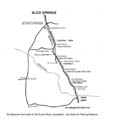
After getting rubbish bags we leave Alice Springs on Wednesday,
May 4, and make our way south towards Maryvale Station.
On our way back from Chambers Pillar we had already taken
a few GPS positions for possible spots where it could be
good to watch the race.
There is lots of traffic on the road .... motorbikes coming
back from training, vehicles with motorbikes and buggies
on the back or on trailers .... and also a small 2WD car
with some Aboriginal people in it.
We let them pass so they don't have to swallow our dust.
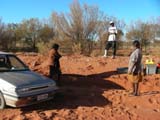
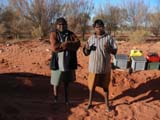
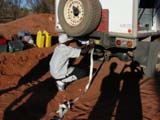
Later on, as we are lowering the tyre pressure they pass
us again.
Shortly after we reach a sandy patch and find the 2WD bogged
in the middle of it.
We stop and agree to pull them out.
It is amazing how far these people get with these cars ....
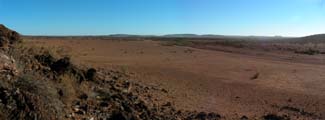
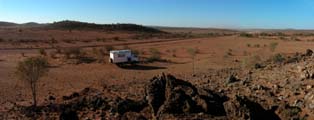
Then we continue on and start checking out our spots.
At the second one, south of Bokhara, we stay for the night.
We are surprised about the amount of traffic on this track
but guess that lots of it has to do with the races.
On Tuesday morning after a rather cool night with only 5°C
we are woken up by beautiful sunshine.
Soon after the first cars drive past us.
We are please to see that the dust stays way below our OKA
which could be good for the races.
At around 9 AM two 4WD drive pass quite fast and just a
few hundred meters behind them a helicopter follows just
about 100 m above ground.
We guess that it has to do with the races too, probably filming
the track.
It looks really good how the helicopter chases the dust-cloud
of the 4WDs.
We drive south to Maryvale to the art gallery to check
if the picture we saw last week is still for sale.
But bad luck, it has been sold in the meantime.
The lady in the shop just says "If you find one you
like you have to buy it on the spot ....."
In just one week they have sold so many pictures.
We are happy to find that our "second choice" is
still there and buy it quickly.
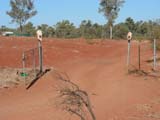
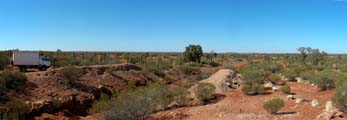
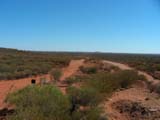
We leave Maryvale on a small track marked with "Finke".
At the gate we stop for Susi to take a picture and to let
an oncoming LandCruiser pass.
The driver of the LandCruiser happens to be the owner of
Maryvale Station.
He informs us that this track is a private farm track; the
public track is off Rodinga, some 10 km further north.
We explain to him that we are volunteers that will collect
the rubbish after the race and ask him for instructions on
how to find the turn off to the track that leads to Finke.
He explains it to us and at the end the instructions adds "....
but you can continue on this track, I give you the way of
right on it."
That's nice of him.
Thanks.
After a bit of a chat he leaves and we continue on towards
the race track.
Once on the Finke race track we turn south and on a narrow
stretch of the track we soon find a good spot for watching.
As the race track is already open for training some motorbikes
come past and we get a first class idea on how it would be
to watch the race from here.
While Ruedi takes the GPS position Susi goes on a short photo
session.
She hears a motorbike coming from south and gets really close
to the race-track, which is normally located a few meters
beside the regular Alice - Finke track, to shoot a picture.
But the bike comes on the regular track heading north ....
and Ruedi is just turning the OKA on the track on the other
side of the crest to head south on the track!
Quickly the motorbike is stopped and after a bit of a puzzled
look from its rider he understands that he would have raced
head on into the OKA.
Because the OKA had not been moving fast there had been no
dust in the air and therefore the rider of the motorbike
had no chance to realise that there was oncoming traffic.
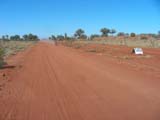
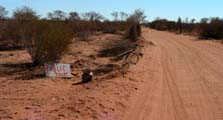
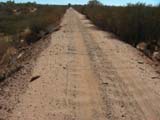
After every 10 km there is an old bonnet on the side of
the track indicating the distance from/to the start/finish
line south of Alice Springs.
We continue on and keep taking positions of possible spots
to watch the race.
Each of them gets a rating but somehow we don't find the
ultimate spot and decide to turn around at Bundooma and head
back to the spot where we had already spent the night.
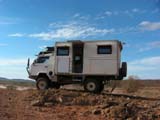
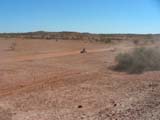
We park the OKA in such a way that the dining table window
faces north and we will have a fist class view on the oncoming
competitors.
In this section the race track runs on the Old South Road
for about 40 km.
It is the high-speed section of the race where buggies reach
a speed of up to 210 km/h.
There is a crest nearby where we might get some great shuts
of vehicles flying over the crest .... we will see.
Besides that should the rain that is forecasted for Saturday
really come we have a great spot on rocks above the track
and should have no issues getting bogged with the OKA in
mud as we would in a clay-pan.
On Friday we start our volunteer work and clean up the area
around our camp.
It seems to be a popular site for the races, especially the
little hill that allows excellent views to all sides.
It is littered with cans of all brands of bear (except VB!!),
mixed drinks and a few soft drink cans.
Most of the cans have been shoved into and under the rocks
and it is a real pain to get them out.
This indicates that the people leaving their rubbish here
are mainly non-indigenous ....
We also collect a few bottles but leave the many broken
ones alone; it is just too much work and too dangerous to
collect the glass bits!
Then we concentrate on the surrounding area.
Here mainly VB cans are just thrown on the ground. They are
easy to be picked up.
This rubbish indicates that it is mainly left by indigenous
people.
You wonder why we think so?
Aboriginal people that drink usually drink VB (because it
is the strongest bear you can get for a good price).
And they don't bother squashing the cans and hiding them
under rocks or smashing bottles.
They just through the empty cans and bottles away.
Quickly the pile grows ....
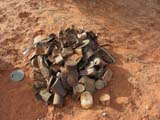
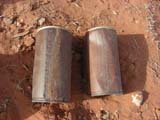
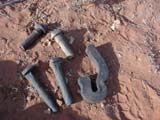
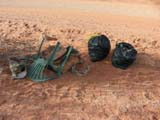
Next is the old race track on the other side of the road.
Here we mainly find old tins and also old drink cans.
Also some bits and pieces of the old Ghan track are lying
around but we leave them as souvenirs for tourists.
After a few hours of work we have collected some 76 lt of
cans, all compressed before we put them in the bag to save
space ....!
All is dumped at the side of the road so it can be taken
to Alice Springs after the race.
Let's hope the place is kept clean during this race.
During the afternoon clouds start appearing and it looks
like the forecasted rain is building up.
If it comes down as a drizzle it will be a blessing, if all
comes down in one quick fall it will generate a mess, especially
in the area with clay-pans around Rodinga.
Well, we will see .....
On Saturday morning we pick up some more rubbish.
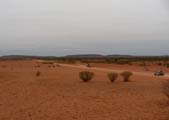
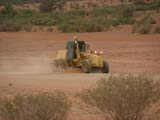
During the morning a grader clears the border of the track.
The weather does not look very promising ....
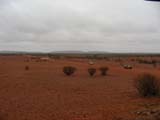
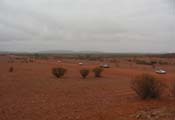
More and more spectators and support crews pass our spot
to get to their preferred location along the race track.
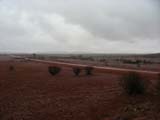
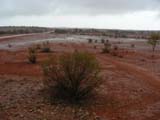
Then the rain sets in.
First the water just disappears in the sand but then puddles
of water start appearing.
The track slowly but surely is turned into a muddy slippery
something .... the vehicles slide and slither past our OKA.
The rest of the day we read books and wait for the rain
to ease .... but it doesn't.
As it gets dark the lights of the vehicles travelling
south shine on the wet track ....
Sunday - first leg of the race.
It is still overcast with still a bit of drizzle falling
and only 11°C.
Today the competitors race 226 km from south of Alice Springs
to Finke.
We listen to the start of the race on ABC radio.
First the
buggies and cars are started; the fastest 10 from the prologue
as single vehicles and the rest in groups of 2.
Then quads are sent on their way in pairs of 2 in one-minute intervals.
Then the bikes are started; the fastest 10 from the prologue in groups of 2and
the rest is started in blocks of 10.
This equals to nearly 1 hour until all bikes are on the track .....
We also hear that Alice Springs has
received more rain than we have and that the start area
is very messy ....
The starting vehicles have to cross a
large puddle of water at the starting line and the more vehicles
start the deeper the mud gets.
Some of the vehicles get stuck and have to be helped out
....
Finke Race control uses UHF-radio and a UHF-repeater station
along the track as the main communication media between the
various full points, check points, the finish line in Finke,
the police and the ambulance.
This gives us the possibility to listen into what's going
on during the race.
This makes the race even more interesting as the progress
and positions of the riders are also constantly reported
on the UHF-radio.
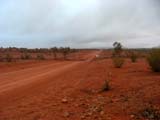
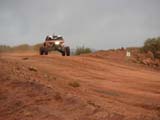
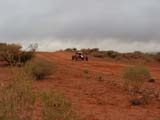
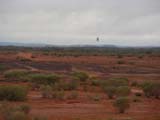
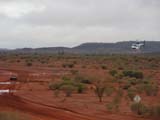
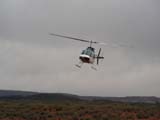
Then the first buggy arrives with a helicopter flying low
over it.
The second and third buggy are also followed and
closely monitored by TV-helicopters.
Watching the helicopters fly over the buggies and the buggies
chasing each other is fascinating ..... have
a look for yourself by
clicking here  . .
The pro-buggies reach about 190 km/h this year at our spot.
While the off-road buggies, 4WD's and 2WD's are passing
our spot the track is still wet and there is quite often
a slight drizzle.
This is good as it keeps the dust away.
We move down to the gate where there
is a small depression to get a bit more action in the mud
....
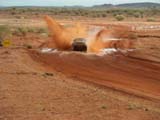
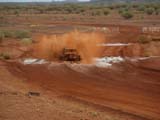
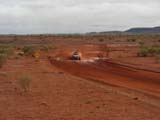
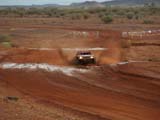
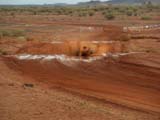
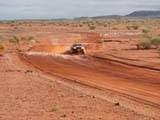
Some of the cars have a windshield that protects the drivers
from the mud but most buggies and many cars don't .....
The poor buggers get plastered with mud in their vehicles!
Click here  to view the buggies
and
here to view the buggies
and
here  to view the cars. to view the cars.
One of the buggies chickens out and tries to avoid the mud
.....
Click here  to view the movie. to view the movie.
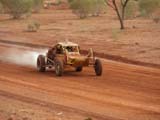
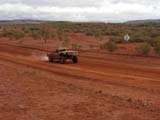
it is hard to tell if the smoke that they are blowing is
just water from the puddle that is drying off or if they
are burning oil ...
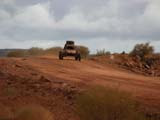
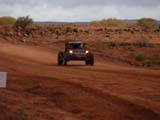
Since the vehicles are started one by one in intervals of
a minute there are not many cars passing by at the same time
and we have time to study them.
It is hard to believe that these buggies are very very expensive
....
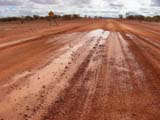
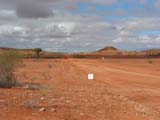
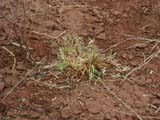
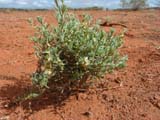
Then the weather clears up and the sun breaks through.
It is amazing to see how quickly nature reacts and the dry
stuff turns green and starts providing flowers in no time!
The better weather comes just in time for the quads and
motorbikes arrive at our spot.
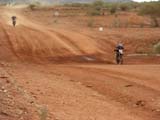
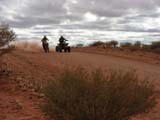
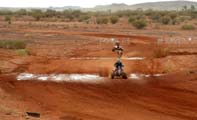
By the time they reach us the bikes have caught up with
the quads.
Mind you, overtaking is not easy because either there is
dust ... or there is mud!
Click here  to view the quads. to view the quads.
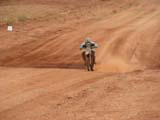
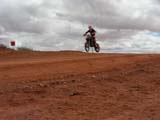
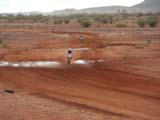
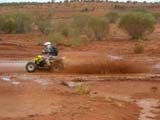
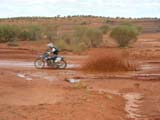
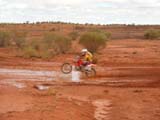
The bikes are much more interesting to watch than the cars
and there are of course much more bikes passing at a given
time.
It is amazing that some bikers even find time to wave at
the spectators when they pass by.
After the race we drive further south to the area of Maryvale
where we will stay for the night at the spot we have chosen
for tomorrow.
South of Rodinga the track is pretty rough and chewed up
from the many cars that have been driving through it during
the rain.
We take GPS waypoints where we see spectator or support
camps so we don't miss the spots on our rubbish pick-up run
on Tuesday.
Unfortunately there are quite a few accidents and injuries
along the track during the race-day.
In one instance even one of the bike riders dies.
He hit a tree about 160 km after the start.
Nevertheless the race continues and also the Monday race-leg
back from Finke to Alice Springs will not be stopped.
Monday - the second leg of the race.
Today the weather is more to our liking - sunny!
It is a cool 6°C in the early morning but it the temperature
raises to 23°C during the day.
Today the competitors will tackle another leg of 226 km
from Finke back to Alice Springs.
Especially the bike-riders feel their tired muscles and many
accidents happen due to fatigue.
But fortunately no more serious accidents happen today.
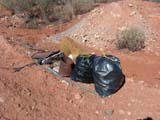
We pick up the rubbish on and around our camping spot before
the race starts.
The friendly owners from the Maryvale store will take the
collected rubbish back to the community after the race.
Thanks guys.
A lot of Aboriginals from the close-by Maryvale arrive
to watch the race.
They are real race-enthusiasts.
Some children ask us for lollies but are quite happy to
get an apple instead.
Today's spot is on a slower part of the track with a lot
of nasty "woops".
Again the cars and buggies are started before the bikes and quads and again
the first few are escorted by choppers ....
Click here  to view the movie. to view the movie.
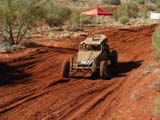
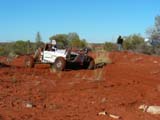
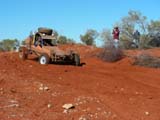
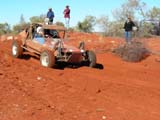
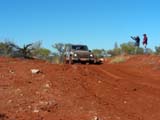
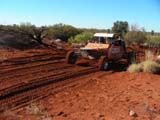
It is absolutely amazing how fast the
buggies manage to cope with the severe bumps of the track
... Click here  to view the buggeis. to view the buggeis.
But many of the competitors have broken down already ...
others sound very sick when passing by ..... including some
of the favourites.
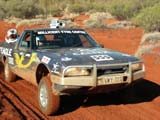
Some cars are all made up like this one with a dog in the
back of the ute ...
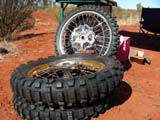
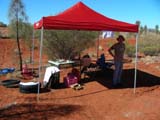
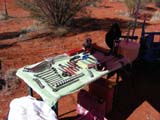
Just a few meters down the track there is the pit stop of
one of the Honda crews.
They cater for a few bike-riders from their company including
for the boss.
It is quite interesting to watch them setting up all the
tools, the refilling station, some spares, drinks and food,
etc.
Then their rides arrive and a hectic rush starts.
Quickly fuel is refilled, the driver supported, new equipment
given, every second counts .... and then the bl..... thing
does not start anymore!
Click here  to view the movie. to view the movie.
The next few go well, no worries, have a look and
Click here  to view the movie. to view the movie.
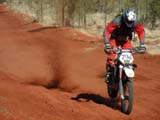
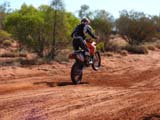
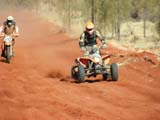
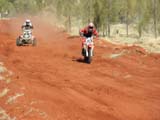
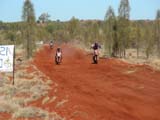
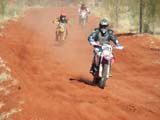
Again there is much more action with the bikes than with
the cars.
It is amazing how they manage to drive over 450
km in 2 days under tough racing conditions without falling
to pieces!
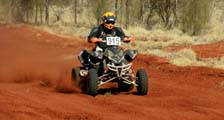
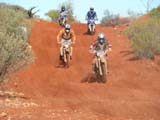
The section with the woops is very special.
Click here  to view some quads
and here
for to view some quads
and here
for
 of
some bikes in the woops. of
some bikes in the woops.
Every so often we hear about injuries along the track.
A rider
dislocates his shoulder near our position, gets back on the
bike and drives about 15 km on the regular track to the next
checkpoint for medical treatment.
Directly in front of us one driver falls down but fortunately
doesn't get injured and can continue the race.
Click here  to view the fall. to view the fall.
Also a very special person, Isaac Elliot, is the rider
of bike number X61.
Last year during the training for the
Finke Desert Race he broke his backbone and became partially
paralysed.
This year he races again .... as a paraplegic!
He rides a
custom built bike with supports to hold him on it.
He
also is accompanied by 4 support riders which should he
fall would have to lift him back onto his bike.
The first incident
already happens at the start line when his race clothes catch
fire while he gets ready to start.
Being fixed on his bike he cannot just hop off so his trousers
get a bit burned but luckily he remains unharmed.
After extinguishing the
blaze he takes off with some delay but manages to catch up
with the rest of the field.
Click here  Click here for a movie of him managing the
woops. Click here for a movie of him managing the
woops.
X61 finishes the race as 262 of 503 riders!
Congratulation.
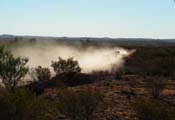
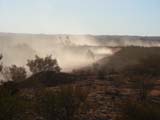
Then the race is over, the spectators and the support crews
go home and the desert gets quiet for the night ......
On Tuesday we drive south to Bundooma where we start collecting
rubbish.
The place is a mess and soon we realise that
we will run out of plastic bags in no time.
We flag down all the cars passing by and
ask them for garbage bags.
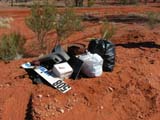
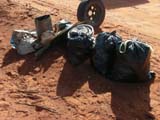
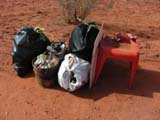
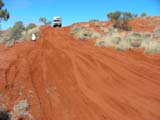
The piles of rubbish bags grows and grows and within a few
hours we realise that it will be impossible for us to
carry the waste back to Alice Springs.
It is simply
too much!
We call race control and let them know about this problem.
We agree that we will make depots along the Old South
Road, take pictures and GPS positions of the rubbish, estimate
the m3 and enter all in a EXCEL-file.
They will then send a truck out to pick it up.
Slowly we make our way up from Bundooma to Rodinga.
But in Rodinga we give up; the task is just too big to be
tackled by just 2 people!
We return to Alice Springs on Wednesday evening and present
the result of our collection to the race office:
we collected
5 1/2 m3 of rubbish on a stretch of roughly 40 km in 3 days!
Finished the collection up to the Start / Finish
line would take us at least an extra week ....
We leave the problem with them and head over to the Big4 Caravan
Park where we take a long long shower .....
The next day we head into Alice Spring for some shopping.
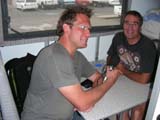
When leaving Coles and returning to
the car park a German speaking radio correspondent waits
for us at the OKA.
He travels around Australia and
finances his travel with interviews he makes from various,
German speaking travellers.
He then sells the interviews
to SBS-radio (the radio station for immigrants).
He has seen our ".ch" on the OKA and now would like
to interview us .....
There is only one small issue: Thorsten
has already made 3 interviews in Alice Springs ... so we
agree that this interview has been made at the shopping centre
in Tennant Creek.
Also we cannot say "you" to each other,
we have to be formal.
This works at the beginning but only for a short time ....
and at the end, when Thorsten finishes the interview!
Anyway, we have a lot of fun making the interview and without
being selfish we believe the result is very good.
But judge
yourself:
Interview
in German
(file type: .mp3, size: 2'797 KB).
Thanks to Radio SBS (www.radio.sbs.com.au)
and Thorsten (www.creutzburg.eu
) for allowing us to publish the interview on our
web page.
Note to the reader:
Only a few weeks later we drove through Tennant
Creek and of course had a look at the local shopping area
....
If listeners of the interview had been to Tennant Creek
they will instantly notice that the interview could never
ever have been done here ..... because there is almost no
traffic in that little sleepy town (no traffic noise) ...
and the "shopping centre" is so small that one
would never hear trolleys being pushed around
:-)))
After all these race movies one last one .... completely
out of context except that it is from Alice Springs
and made at the same time ...
After the finished rubbish collection we have to stay in
Alice Spring for a few days while some repairs are done at
the OKA (yes, we busted a dog clutch in Ruby Gap ...) so
we move to a Motel as the OKA is not available
during this time.
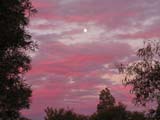
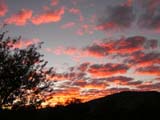
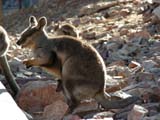
Right outside of our room we can
watch the Rock Wallabies
that come for a visit at dusk and dawn.
Have a look at them and
click here  to view the movie. to view the movie.
And this is the end of this journal ....
|

![]() Created by Level X Webdesign
Created by Level X Webdesign